… I’ll regret having walked into town today.
According to the booking agency, the hotel is just 3700 feet (about 2/3 of a mile) from town. But that’s clearly in a straight line. When you are following a meandering river through the mountains, it’s nothing like a straight line at all.
And when the town is a long, narrow strip of buildings all the way along the valley, by the time that you have reached the end, had a really good look around and then walked all the way back, it’s no surprise to anyone that your fitbit shows 16.8 kilometres – 211% of my daily total.
Last night was rather strange. I went to bed early and crashed out again, waking up to hear the radio still playing at round about 01:00. And so I switched it off and went back to sleep.
All of the three alarms went off of course, but I wasn’t in any rush. 07:30 was when I finally arose.
Breakfast was interesting. Nothing like the one at Lech but that was really something special. This one here, although a long way short of it, was still more than satisfactory. I’m not too keen on powdered orange juice but then again, this is the east.
Sliced banana too, still in its skin. First time that I’ve seen that. But then, 30 years ago, there wouldn’t have been any bananas at all. People have very short memories yet I can tell you hordes of tales about travelling in Eastern Europe back in the 80s.
Last night I was with someone who might even have been a girl whom I used to know of all people. We were certainly on the verge of becoming a couple, holding hands, all that kind of thing, being extremely close to each other. A group of us had gone off somewhere and she was there as well so she came. I had extremely high hopes about this but the more into this trip we got and the more things started to become evident that the kind of life I was living at the time was not the kind of life that other people were living, that my family was living she became more and more distant. By the time I got somewhere to stop for a coffee she just disappeared. We’d seen some really interesting fountains and of course I didn’t have my camera with me so I went to get the one off the phone to take these photos but it turned out hat I had the dashcam. By the time that I’d put that away and got the phone out ready to work everyone was all coming back and we had to go back. She wasn’t there and I wondered where she had gone. I was with my family by this time and we ended up in a hospital. All my family was being treated for cancer and I had to go to have my treatment too. One of my sisters was there being treated and my grandmother was there being treated. My sister having a perfusion had lost an arm or a thumb along the way. They were all talking about they’ll be out by March and I thought “God! March – I’ll just be beginning”. I had to look for them and I ended up going to the wrong house or wrong hut where they were staying but someone put me right. I was talking about a message that we were all going to receive from the Government. Someone called me forward , it was one of these “pat on the back of the head” type of things and I couldn’t wait to read it and have a good laugh. I tracked my family down and they were living in some miserable hovel or wooden hut. As I said, my sister had lost an arm and was there with a perfusion and my grandmother was there with a perfusion and it was all one hell of an untidy mess. I was thinking that if the girl whom I mentioned shows up now if I made it up with her this is going to be the absolute end. She’ll never speak to me again, not that she was speaking to me at that particular moment. As usual it was my family of course who were causing all these problems with me as I tried to get on in life. All that time as this was going on I was singing that Brian Eno song “we are the 801” and that’s stuck in my head now.
There was a baseball match of some description. There was a little boy playing in it and he’d scored some kind of record number of runs in a match. he was very lucky because he’d nearly been out first ball, where the ball had actually hit an obstruction before it had been caught by a fielder. And somewhere in this was a girl to whom I used to be engaged when I was much younger. There was something going on with the coaches and I can’t remember now. She was there and I’d been with her and ended up talking to the woman who owned the coaches in the end. She was asking me about the girl and how well I’d known her. I replied that I’d known her since she was about 13 when she came from Arbroath and we’d gone out with each other at school, all that kind of thing. We’d separated and got back together again, and separated and got back together again. She was pointing out some kind of erratic behaviour of my girl and was under the impression that she was spying on the coach company for some reason or other, which I found very hard to believe. I thought that she was waiting for me while we were having this discussion. All kinds of weird little things like that and I can’t remember them now which is a shame. There was certainly something where I was with someone in a car and she was going to visit someone for work. We were having a quick kiss and cuddle in the car and all her clothes were creased and she had to walk to this house straightening all her clothes as she went. I’ve a vague feeling that TOTGA put in an appearance too at some time during the night although again I don’t remember anything about it particularly
I can’t remember who I was with now but we were driving around and came across what was Tatler’s Garage or what should have been Tatler’s garage. It had “Tatler’s Garage New For 94” and we were wondering what was new. We had a look but it was all deserted and derelict, the doors had been left open and the building was decaying and there were people down there. We were wondering whether we should go down there and have a look and find out what was going to be so new about 94 with the range of Peugeot vehicles that they were selling
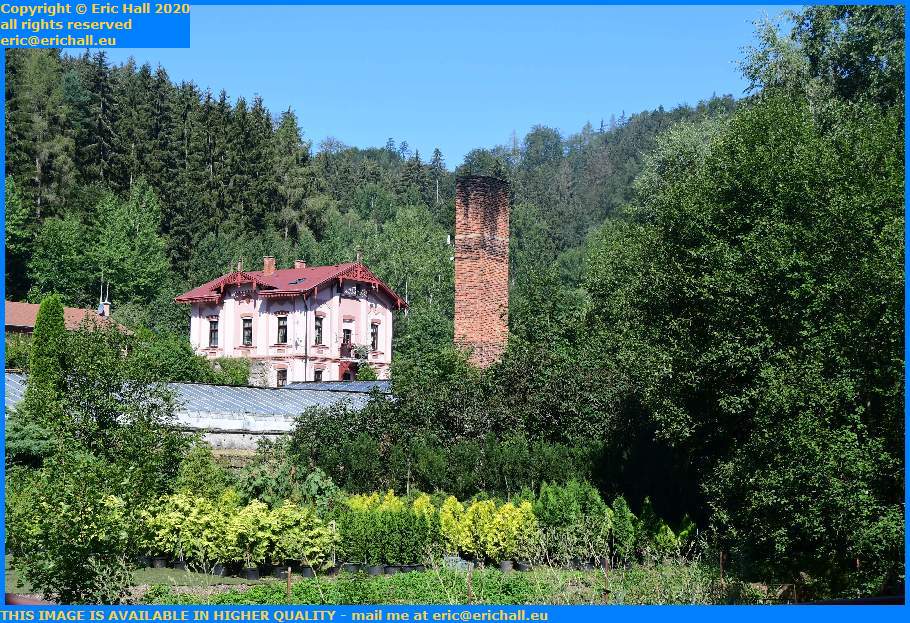 Round about 10:30 I set off on my marathon hike into town.
Round about 10:30 I set off on my marathon hike into town.
However I didn’t go very far before I was side-tracked. I ended up having a good walk around the little town where I was first – mainly because I noticed this old chimney.
By the looks of things, over there, there’s a huge greenhouse complex over there across the river and so what that chimney might be doing – pure speculation here – is that it might be for a furnace for heating the greenhouses in order to give everything a head start in spring.
Regular readers of this rubbish will recall that back in days gone by I used to cover my ground with thick black plastic for the same reason.
 Did someone say “river” just now?
Did someone say “river” just now?
Right across from the hotel behind a row of houses is the River Tepla. If I walk on about 200 yards there are no houses and so I can see the river quite clearly.
I’m told that its name, Tepla, means “warm” in old Slavonic which of course makes perfect sense because Karlovy Vary near to where we are is one of the most important Spa towns of Central Europe with warm springs just about everywhere.
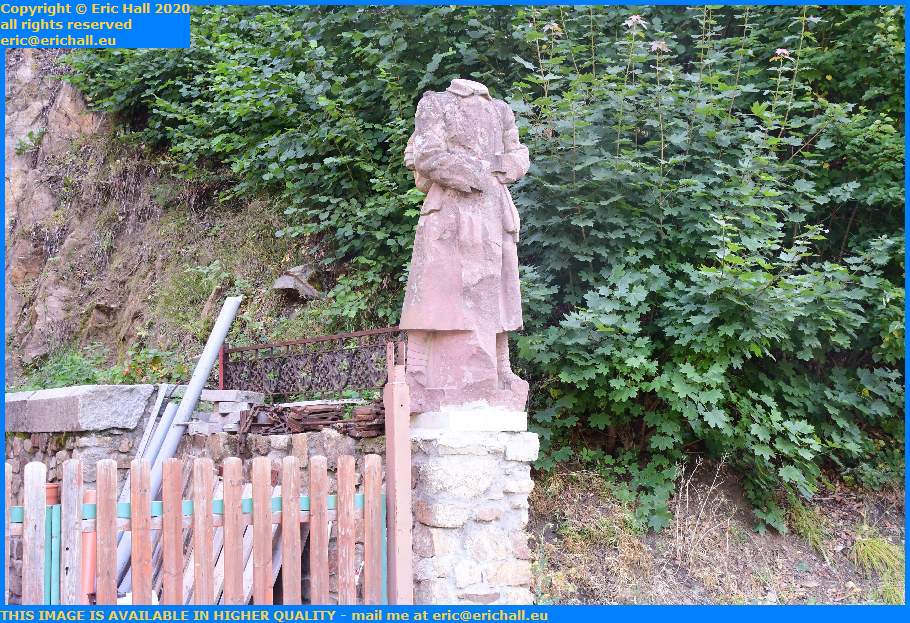 This was something that I found quite interesting, and if only my Czech were good enough to ask someone about it.
This was something that I found quite interesting, and if only my Czech were good enough to ask someone about it.
It is of course a soldier and the clothing puts it at about the end of the 19th Century and maybe just about into World War I. But for what particular reason would anyone want to decapitate it?
It’s probably necessary to mention that here, we are in one of the most turbulent regions of Central Europe. This was a part of mainstream German-speaking Bohemia of the Austrian Empire that found itself against its own wishes transferred to an “enemy” country (the Czech Legion fought with the Russians in World War I and continued the fight against the Austrians after the October Revolution) in 1919.
After years of agitation it was absorbed by Germany in 1938 (the Sudeten Crisis) but in 1945 the Czechs recovered the area and all of the Germans were forcibly expelled.
And so this symbolic act of decapitation (if it really is a symbolic act and not something that has been done by accident) could refer to almost anything.
 It’s a very long walk into Karlovy Vary as I mentioned earlier. But there was plenty to see on the way.
It’s a very long walk into Karlovy Vary as I mentioned earlier. But there was plenty to see on the way.
Lioke this car, for example. A Renault of course, but not one that you would expect to see on the roads in France. And although it’s described as a Renault Thalia, regular readers of this rubbish will recall HAVING SEEN ONE BEFORE when it was called a Renault Symbol.
It’s basically a Renault Clio destined for markets where hatchbacks aren’t very popular, and they are made in Turkey.
 It’s quite a slog into town from Bresova where my hotel is, although it’s a beautiful walk, I have to say, and although it was sunny, it wasn’t too hot.
It’s quite a slog into town from Bresova where my hotel is, although it’s a beautiful walk, I have to say, and although it was sunny, it wasn’t too hot.
But sooner or later we eventually begin to see the signs of things to come, like this magnificent building that can only be a hotel situated on top of a ridge.
It is in fact the Hotel Imperial, dating from 1912 and I was proudly told that it was the first building in what is now the Czech Republic to have been built with poured concrete. There’s a road that goes up there of course, but there’s also a cable car, so I was informed.
Just about anyone who is anybody has stayed here in this hotel and I can well understand it because I have seen the prices.
 But before I can reach where the Hotel Imperial might be situated, I start to encounter a few more hotels. I must be reaching the town now, or at least, something connected with it.
But before I can reach where the Hotel Imperial might be situated, I start to encounter a few more hotels. I must be reaching the town now, or at least, something connected with it.
This is the Park Hotel Richmond. Although its history goes back to the middle of the 19th Century the present building dates from 1925. And there’s much more of it than you can see in this photo because altogether there are 5 floors and 117 guest rooms, as well as a whole host of other features.
It’s well hidden inside its own little park and you wouldn’t ever know that there’s so much of it here.
 One thing about Karlovy vary with it being the haunt of the rich and famous, is that there have been all kids of people who have come here.
One thing about Karlovy vary with it being the haunt of the rich and famous, is that there have been all kids of people who have come here.
Amongst the visitors here was Ludwig Van Beethoven, who came here on two occasions in 1812.
And if you think that his monument is rather grand, it’s rather a cheat, because it’s not really “his” monument. There used to be a statue of the Emperor Franz Josef I of the Austrian Empire on this spot but once Czechoslovakia was created, then it was only natural that the Emperor received his marching orders.
Beethoven has in fact only been here since 1929
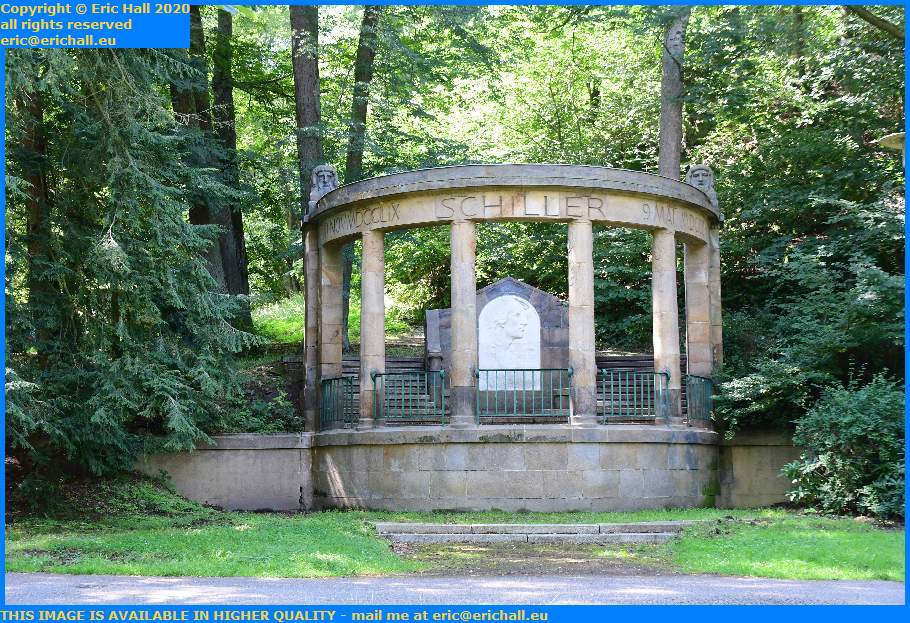 Someone else who had a famous stay in Karlovy Vary was the German playwright and poet Freidrich Schiller.
Someone else who had a famous stay in Karlovy Vary was the German playwright and poet Freidrich Schiller.
He came here in 1791 and during his stay he began to write his “Wallenstein Trilogy”, the story of the Bohemian General von Wallenstein who despite being born a Protestant, led Catholic forces against the Protestants in the 30 Years War, just one of the many, many reasons why he was such an unpopular character.
During a programme of Embellishment of the town during the early years of the 20th Century the committee in charge of the programme engaged architects Freidrich Ohmann and Max Hiller to design this memorial to celebrate the 150 years of Schiller’s birth in 1759.
And when I saw it, I couldn’t help but think of a couple of lines of the poem written by Conrad Meyer about the funeral of Schiller –
A waving pall. A vulgar coffin made of pine
With not a wreath, not e’en the poorest, and no train
I wonder what Meyer would have to say about this memorial.
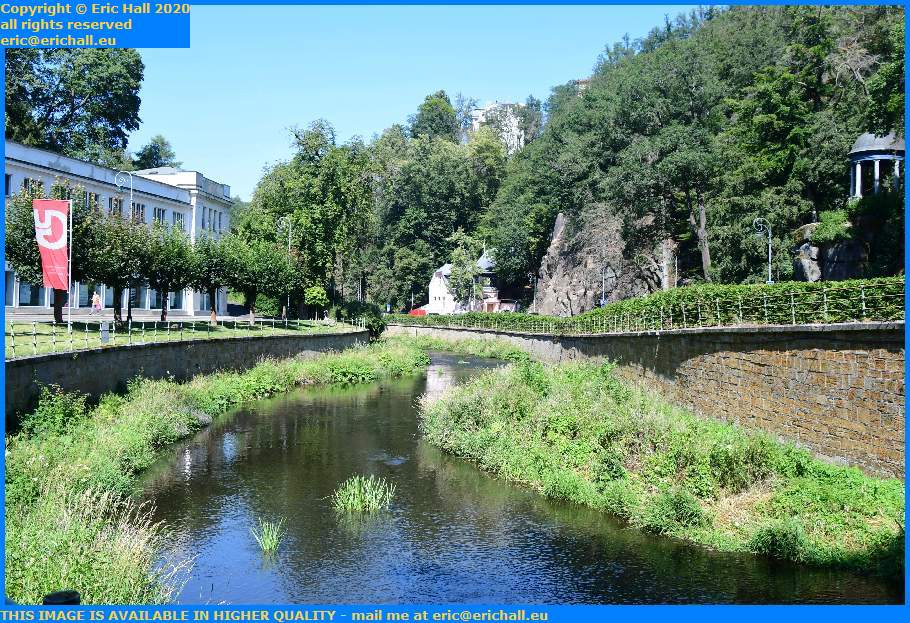 If anyone thinks that I’ve arrived at the town now, they would be mistaken. There’s still a long way to go yet before I reach the end.
If anyone thinks that I’ve arrived at the town now, they would be mistaken. There’s still a long way to go yet before I reach the end.
Here, I find myself in another gorge and I need to push on from here. I’ll be following the River Tepla again, nicely canalised with proper stone.
On my left is the Art Gallery. I meant to take a photograph of it from a better angle on my way back and to my bitter regret I forgot. But it’s a beautiful building that also dates from the Embellishment programme of the early 20th Century. Prior to this, it is said that this was an important shopping area, although the clients must have had something of a walk to reach here.
 But I’m not going that way quite yet. I’ve been side-tracked by this strange machine.
But I’m not going that way quite yet. I’ve been side-tracked by this strange machine.
It’s obviously a bicycle of some kind and this little boy is having a whale of a time riding up and down in front of the Art Gallery.
Had my Czech been up to anything I would have asked him about it and even maybe cadged a lift into town. But unfortunately the Czech Republic wasn’t a member of the EU when I working was there so I never had the opportunity to learn much of the language.
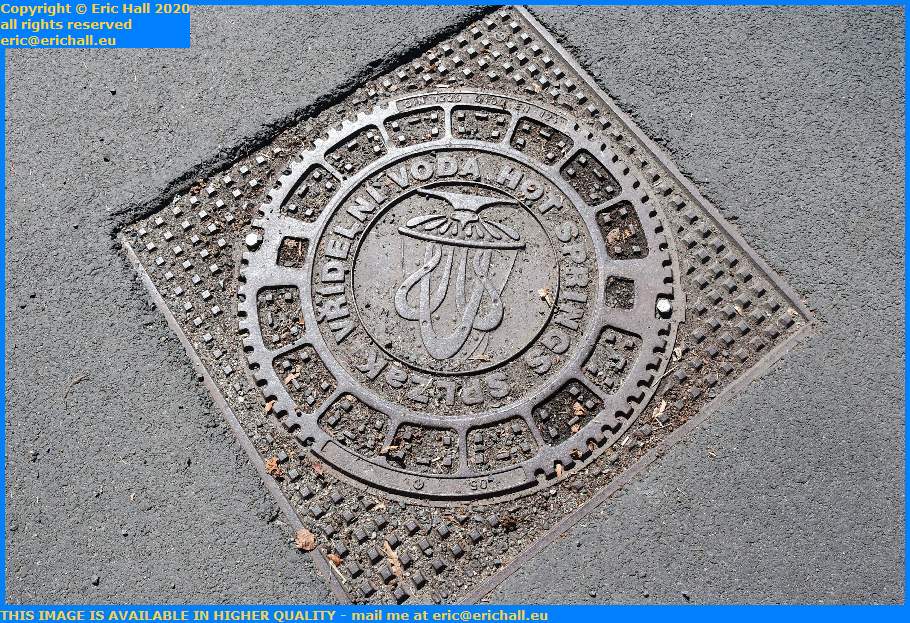 But before I move away from here there is one thing that I ought to be photographing.
But before I move away from here there is one thing that I ought to be photographing.
Karlovy Vary is, as I have said, famous for its hot springs and there is thus a considerable volume of hot water that is being discharged throughout the town. So even some of the manhole covers have a warning written on them to inform whoever might want to lift off the cover that there’s hot water flowing by underneath.
This kind of place looks like the kind of place where I would like to sit in the middle of a local Czech winter, and I bet that it’s popular with the local animals too.
 This is a rather depressing thing to see, especially for lovers of James Bond.
This is a rather depressing thing to see, especially for lovers of James Bond.
This is the famous Kaiserbad Spa, designed by Hermann Hellmer and Ferdinand Fellner and built on the sire of a former brewery. It was opened in 1895 and was full of the latest state-of-the-art equipment of its day, even down to the very first electric exercise machines designed by Gustav Zander who exhibited at the Philadelphia Centennial Exhibition in 1870.
It was also the venue for a whole series of international chess championships in the early years of the 20th Century.
With the decline in visitors after World War II it lost a great deal of its splendour and in the 1980s became a casino and then a luxury hotel, both projects which failed spectacularly.
Most people will know it from the James Bond film CASINO ROYALE, filmed in Karlovy Vary, where its exterior was featured on several occasions during the various “entry into the Casino” scenes.
But having been left to ruin for the last 30 or so years it’s slowly being restored. And about time too because by all accounts it’s supposed to be magnificent inside with loads of frescoes and the like.
 Just opposite the Kaiserbad Spa are rows of magnificent terraced houses that must have been where the cream of society came to stay in the heyday of Karlovy Vary in the late 19th Century.
Just opposite the Kaiserbad Spa are rows of magnificent terraced houses that must have been where the cream of society came to stay in the heyday of Karlovy Vary in the late 19th Century.
The name Karlovy Vary might not be very familiar to you but if I were to mention that until about 1945 the place was known as Karlsbad or Carlsbad, then a few bells might start ringing
It was a town considered by many important dignitaries to be the Jewel in the Crown of the Austro-Hungarian Empire, with its 13 major springs and, in total, well over 300 sources of water bubbling away out of the rocks all over the town. Anyone who was anybody wanted to come here to take the waters”.
 It is said that the city was founded by, and it was certainly named for Charles IV, King of Bohemia after he had bathed in a hot spring that he had found in the forest here while hunting, although there were plenty of settlements here already.
It is said that the city was founded by, and it was certainly named for Charles IV, King of Bohemia after he had bathed in a hot spring that he had found in the forest here while hunting, although there were plenty of settlements here already.
A charter was granted to the town by the Emperor Charles in 1370 but it wasn’t until the arrival of the railway in 1870 that things began to take off. And the rise in visitors was spectacular. By the time of the outbreak of World War I there were well over 70,000 visitors coming each year.
With the incorporation of Bohemia into the Austrian Empire in 1526 a great number of ethnic Germans moved to settle in the area, and political turmoil and unrest amongst the mainly German population of the town after the region was incorporated into Czechoslovakia reduced the flow of visitors, and numbers fell again under Communist rule.
It’s only now that the tourists are returning to the area, now that the facilities are being restored.
 We talked about the Jales Bond film CASINO ROYALE just now. This is the Grand Hotel Pupp – one of the buildings that featured considerably in the film.
We talked about the Jales Bond film CASINO ROYALE just now. This is the Grand Hotel Pupp – one of the buildings that featured considerably in the film.
It’s not the only film to have been made here either. There have been about a dozen that I could trace, mainly Czech films, but the Jackie Chan film SHANGHAI KNIGHTS and the Gerald Dépardieu film LAST HOLIDAY are two others that many people might know.
The original building on this site was called “The Saxon Hall”, so-called because the construction in 1701 was partly financed by Friedrich August, Elector of Saxony and King of Poland, and the staff who manned the building came mainly from Leipzig
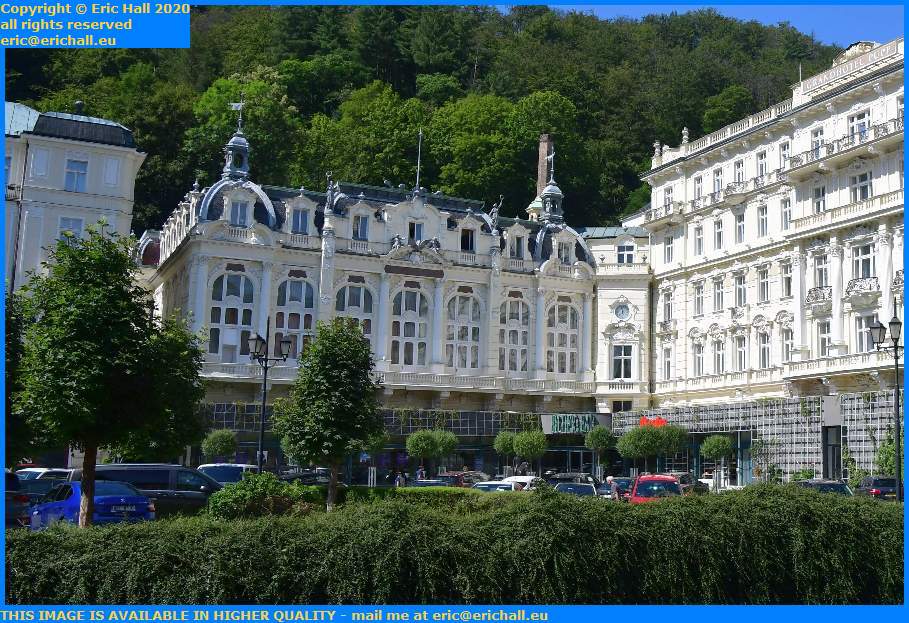 In 1708 the mayor of Karlovy Vary built a competing Hall on an adjacent plot and this became known as the “Czech Hall”. And gradually over the next 70 years or so, various constructions and enlargements continued down the street.
In 1708 the mayor of Karlovy Vary built a competing Hall on an adjacent plot and this became known as the “Czech Hall”. And gradually over the next 70 years or so, various constructions and enlargements continued down the street.
In 1778 the Pupp family, confectioners, bought the Czech Hall and put a lot of effort transforming it into one of the most popular places in the town, which resulted in the owners of the Saxon Hall endeavouring to find ways to out-compete their neighbours and for 100 years a fierce rivalry ensued
This came to an end in 1890 when the Pupp family finally managed to acquire the Saxon Hall and in 1892 the whole site was cleared away and construction of the present building began.
 Since then it’s been through several stages of reconstruction.
Since then it’s been through several stages of reconstruction.
The facade was improved in 1907 thanks to a design by Hermann Hellmer and Ferdinand Fellner whom we met at the Kaiserbad Spa down the road, and in 1923 every room was converted with en-suite facilities. In 1934 the house next door was bought and the hotel expanded. It ended up with a total of 1080 beds at its maximum
Although World War II didn’t affect the town particularly, the hotel became a hospital for wounded German officers. The story goes that a hoard of supplies of coffee and other scarce goods was discovered and was expropriated by the Luftwaffe and the Submarine service.
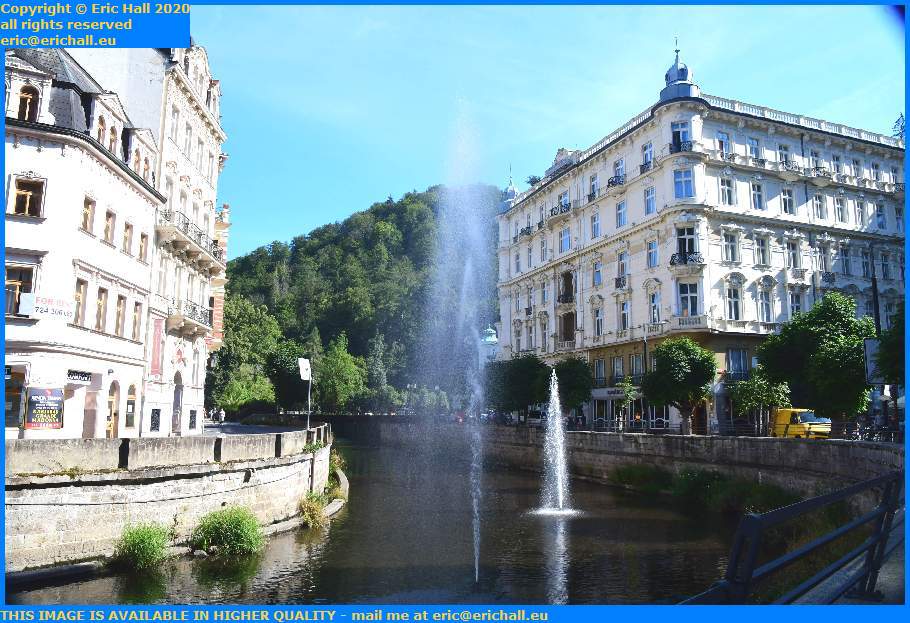 After the War the hotel was nationalised as the Grand Hotel Moskva and became a reward centre for Communist Party officials and exemplary peasants and factory workers. However it was during this period that the hotel became quite run-down.
After the War the hotel was nationalised as the Grand Hotel Moskva and became a reward centre for Communist Party officials and exemplary peasants and factory workers. However it was during this period that the hotel became quite run-down.
Several attempts were made to try to restore it but various political upheavals such as the 1968 invasion disrupted everything. The luxury clientele who had begun to be lured back melted away again in all of the turmoil and it wasn’t until after the end of Communism that things began to change for the better.
In 1992 it was privatised. Its original name was reinstated and the Pupp family returned to the helm, and in 1994 the International Film Festival which had taken place here intermittently in the past now became a regular feature, and led to its appearance in a whole variety of films.
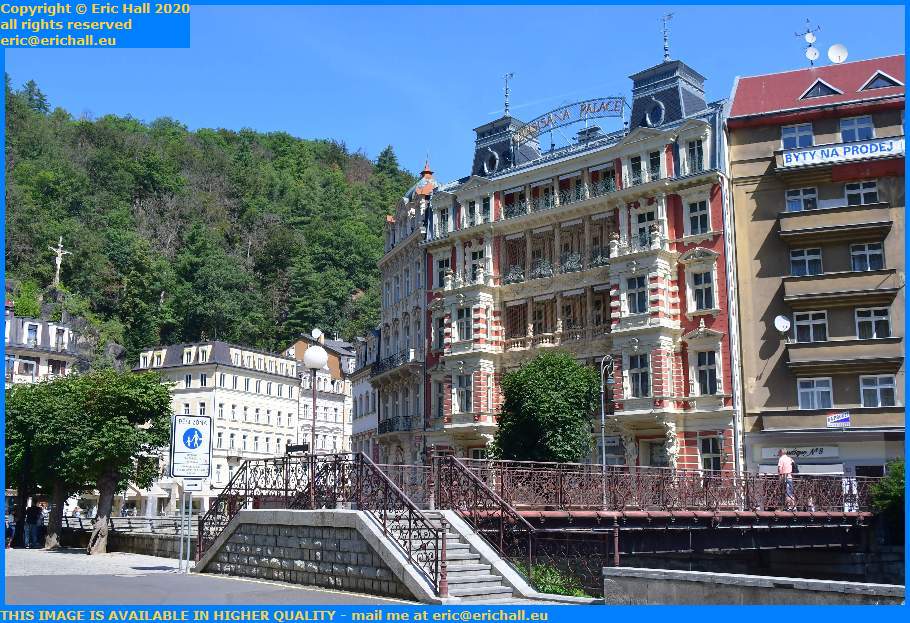 Across the road from the Grand Hotel Pupp is the Quisisana Palace Hotel, one of a chain of hotels apparently.
Across the road from the Grand Hotel Pupp is the Quisisana Palace Hotel, one of a chain of hotels apparently.
It’s a building that was constructed between 1887 and 1888 in a mixture of the neo-Renaissance, neo-Gothic and neo-Baroque styles.
It has 19 luxury rooms and suites and although I wasn’t able to stick my nose in to see what it was like, looking at the photos of the rooms tells me that I wouldn’t be able to afford anythng there. With its spa and massage parlours and all of that, it will be way out of my budget.
The bridge over the River Tepla is very interesting too with its lovely wrought-iron scrollwork.
 Just a little further on from the Grand Hotel Pupp is the corner where the River Tepla turns the corner and heads down into the town.
Just a little further on from the Grand Hotel Pupp is the corner where the River Tepla turns the corner and heads down into the town.
The fountains here are quite nice but they don’t spring up much higher than that.
There was some nice shade just there under the trees. I went along and sat there for a few minutes to take advantage of it. The heat was really oppressive right now.
And it wasn’t until I returned to my hotel and looked closely at the photograph that I saw the statue of Jesus up there on the rock behind the houses. I’ve no idea what it’s for but it’s something to do with the “Forest Devotion”, whatever that might be.
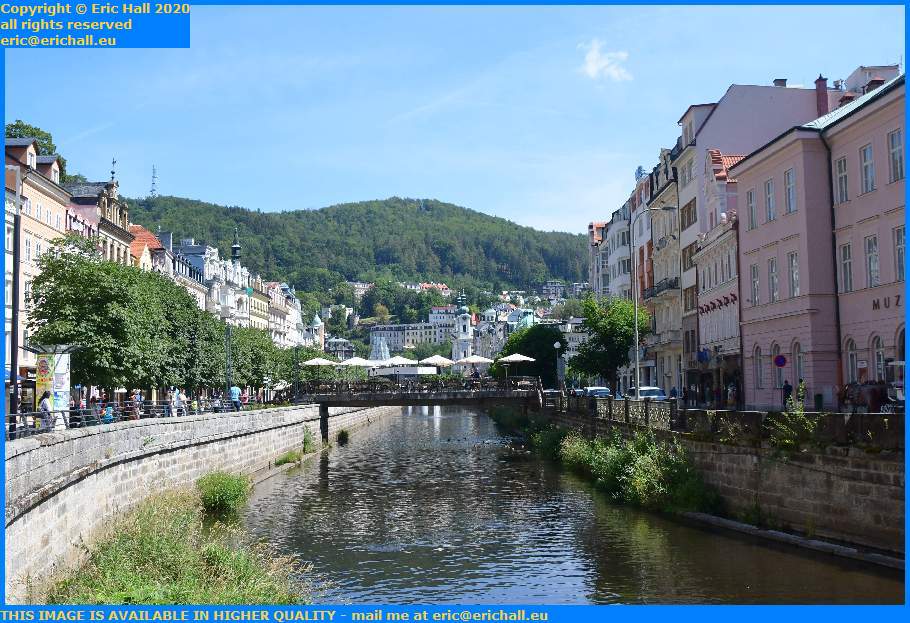 Having restored myself in the shade for a few minutes I could wander off now towards the town centre.
Having restored myself in the shade for a few minutes I could wander off now towards the town centre.
Going around the bend … “quite” – ed … in the river I come out towards the most beautiful riverside promenade, as you can see. It follows the river all the way into the town centre.
And I really do mean “all the way to the town centre” because there was still a long way to go. The town of Karlovy Vary is nestled in a very steep valley so the town is very long and thin as it follows the river valley.
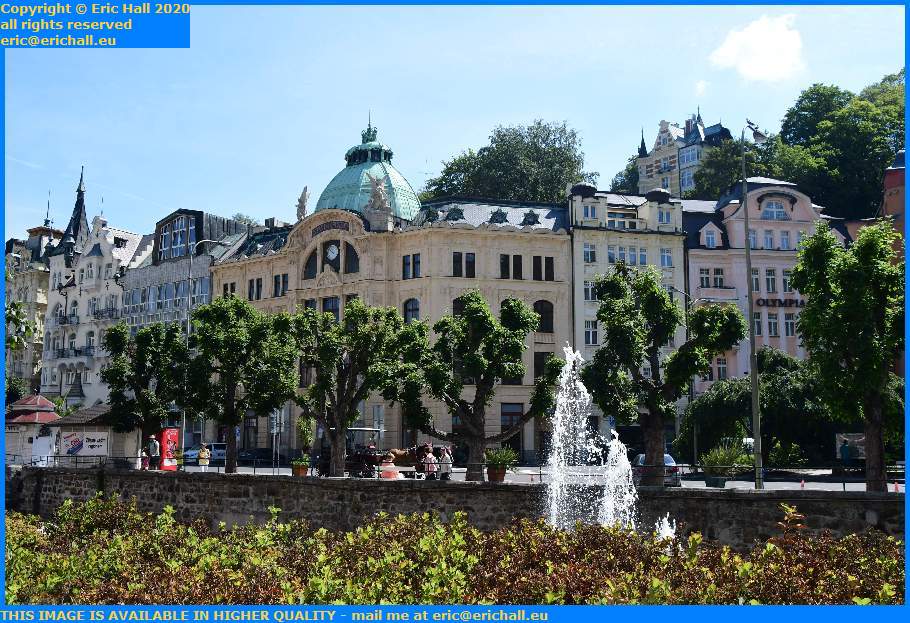 We’ve already seen a couple of fountains bursting up out of the river, and here’s another one a little further along. It seems that fountains are the “in” thing around here.
We’ve already seen a couple of fountains bursting up out of the river, and here’s another one a little further along. It seems that fountains are the “in” thing around here.
More interesting that the fountains though is the yellowish building in the background. Looking closely at it I could see the word “Sparkasse” on the facade just above the clock.
Why that is interesting is because it’s “Savings bank” in German. As I have probably said before, until 1918 this was part of the Austro-Hungarian Empire where German was the main language, and this area was quite Germanic.
After the end of the Second World War the German-speaking population was expelled and the Czech population took over the town. Looking for signs of the pre-1945 Germanic population in these areas is something that I like to do, and here we are with quite a good example.
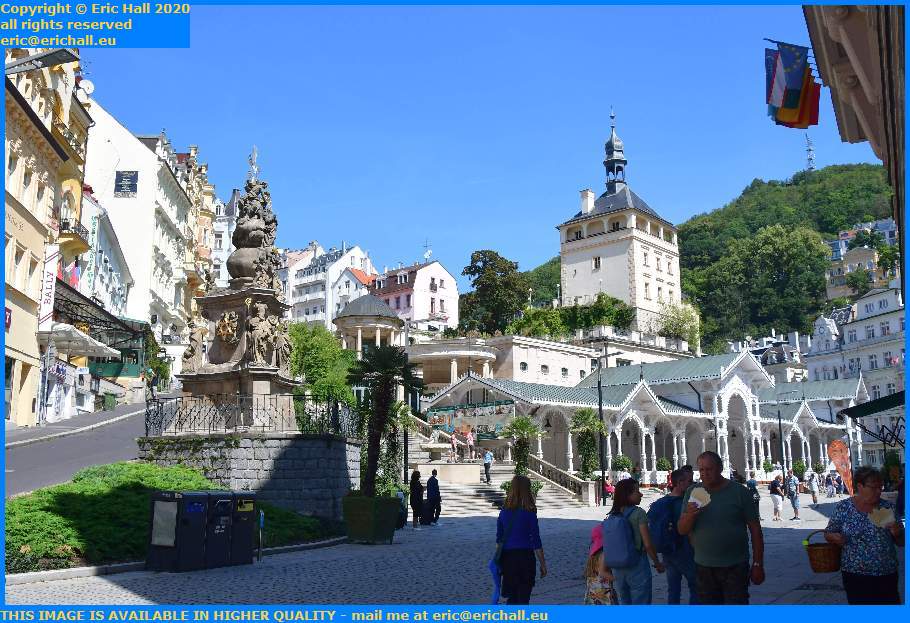 Further along there was a choice of following the river or taking a short cut to cut off a corner by following the Tržište.
Further along there was a choice of following the river or taking a short cut to cut off a corner by following the Tržište.
This street took me past the Market Colonnade. This was built at the height of the period of glory of the town, between 1882 and 1883. It’s a wooden colonnade and is said to be “in the Swiss Style”. The architects were Ferdinand Fellner and Hermann Hellmer.
The reason for its construction was to cover three natural springs, the Charles IV Spring, the Lower Castle Spring and the Market Spring. After 1945 it fell into decay like most things here but was restored during the early 1990s.
 Further along the street I rejoin the river and continue my trek along the promenade and end up at the Mill Colonnade.
Further along the street I rejoin the river and continue my trek along the promenade and end up at the Mill Colonnade.
This is another construction from the belle epoque of Karlovy Vary, designed in the Pseudo-Renaissance style by the Bohemian architect Josef Zítek and built during the period 1871-1881 and officially opened on 5th June 1881. Zitek by the way was Professor of Civil Engineering at Czech Institute of Technology in Prague.
It’s the largest of the colonnades in Karlovy Vary.
On top of the central part are twelve statues. These are allegorical in that they represent the months of the year, although the significance of the statues beats me.
 There are five springs within the building, the Mill Spring, the Rusalka Spring, the Prince Wenceslas Spring, the Libuše Spring and the Rock Spring.
There are five springs within the building, the Mill Spring, the Rusalka Spring, the Prince Wenceslas Spring, the Libuše Spring and the Rock Spring.
On the way out of time I called at the Mill Spring for a drink but it wasn’t exactly cooling. This one here is the Mill Spring and the water that comes out of it is at 57.8°C. That’s not exactly cooling in this weather.
It’s one of the oldest captured springs in the town, dating back to the 16th Century. Back in 1705 it was one of the first to be recommended for drinking and since then its water has been bottled and sold all around the world. I’m not sure why though because having had a mouthful of it I can say that it tastes disgusting. I wouldn’t want to try a bottle full.
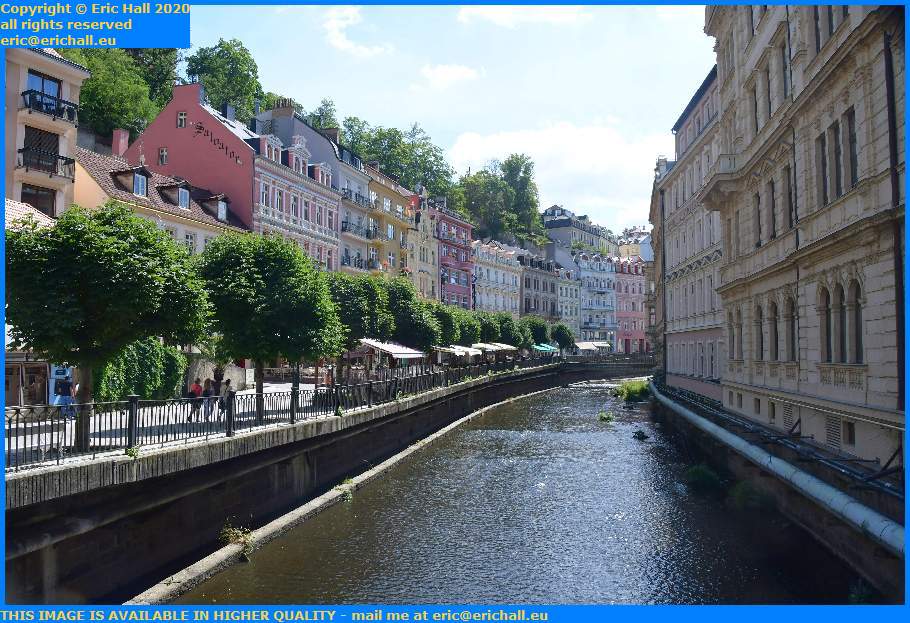 Where I was standing to take the photo of the colonnade was on some kind of plaza built right over the river.
Where I was standing to take the photo of the colonnade was on some kind of plaza built right over the river.
Looking behind me, I can see all the way down the Vrídelní , the street on the right bank of the River Tepla. That’s quite a busy little street with lots of shops, restaurants and hotels all along it and looking at the roofs over there, there’s some kind of street market going on down there too.
On the other side of the river, we’re looking at the back of a block of flats. It’s quite splendid for flats, I have to say, and it’s easy to imagine the people who might have stayed there during the belle epoque at the end of the 19th and the beginning of the 20th Century.
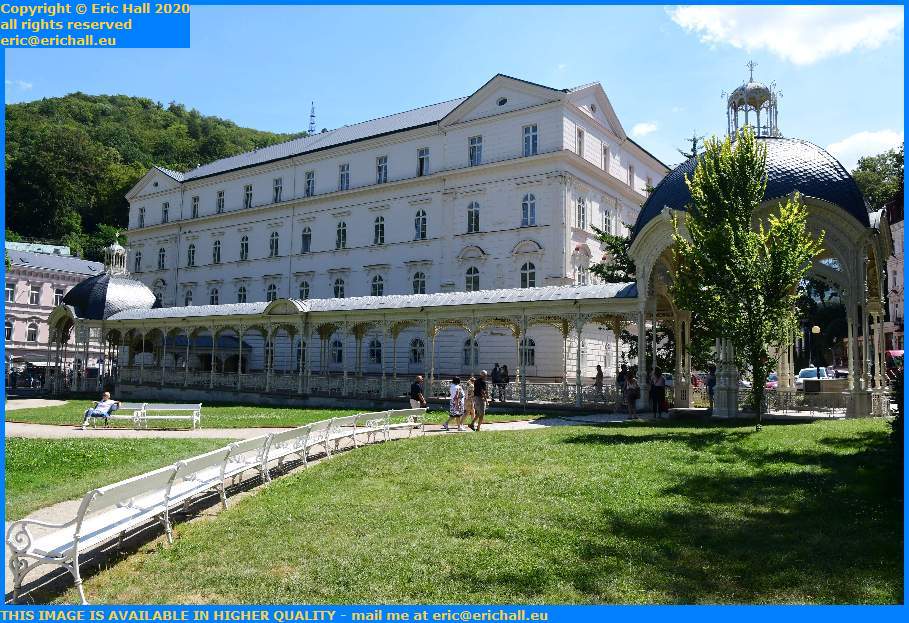 This building here is the Park Colonnade.
This building here is the Park Colonnade.
It’s built of cast iron and is actually all that remains of a restaurant and concert hall that was called the Blanenský Pavilion. This was designed by the architects Ferdinand Fellner and Hermann Helmer who we met a little earlier when we were at the Market Colonnade.
This was built prior to the Market Colonnade – between 1880 and 1881 in fact – and assembled from parts that had been cast at the Blansko Iron Works and was opened on 5th June 1881.
After the end of the Belle Epoque the building suffered badly and by 1965 it was in such a poor condition that it was demolished. Just the colonnade remains today.
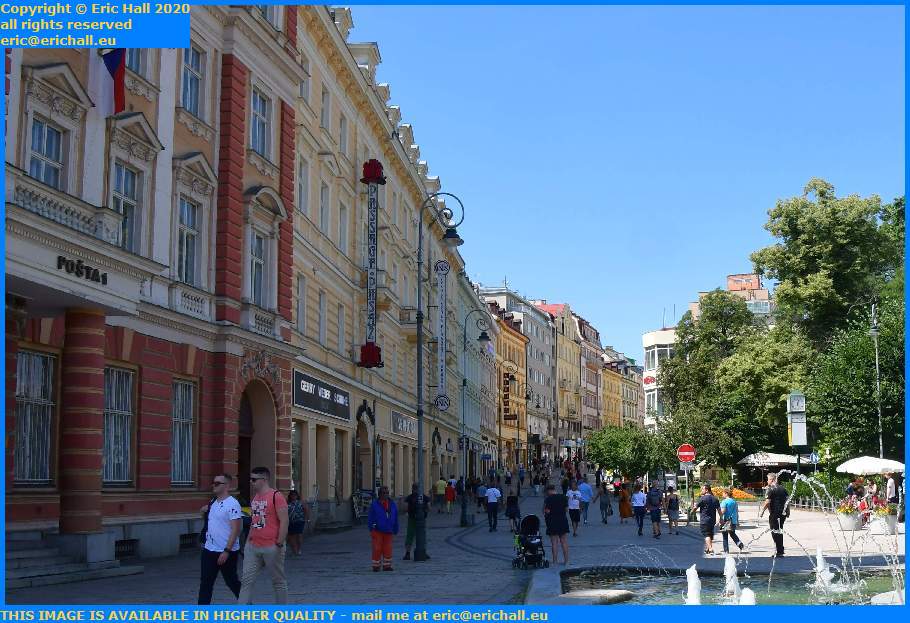 A brisk walk along the river from the Park Colonnade brought me into the modern centre of the town.
A brisk walk along the river from the Park Colonnade brought me into the modern centre of the town.
This is the T.G. Masaryka and it’s around here where you might find all of the modern shops. And if you are wondering to whom the T.G. Masaryka refers, It refers actually to Tomaš Garrigue Masaryk who was a Bohemian politician born in 1850.
Prior to World War I he was working hard to try to convince people to accept the transformation into a Federal State. At the start of World War I he fled into exile and organised the Czech Legion to fight on the side of the Allied Powers with the aim of liberating the Czechs and Slovaks from Austrian rule.
At the end of the war, with the Czechs and Slovaks freed from Austrian domination and was voted President of Czechoslovakia, a position he held until 1935. He was the father of Jan Masaryk, President of Czechslovakia from 1945 until his mysterious death in 1948 on the eve of the Communist takeover.
There was an interesting encounter in this street with regard to money.
The Czech Republic isn’t a member of the Eurozone and still uses Kronor the local currency. At the bank in the cash machine, I was offered 22:13 Kronor to the Euro.
But in one of these exchange booths scattered about the city I was offered 1290Kronor for 50 Euros, an exchange rate of 25.8 Kronor with no commission. And seeing as neither of us had any small change, I ended up with 1300 Kronor.
Someone asked me what I would do if I ended up with money left over after my travels here are over.
The answer is the same that we used to do back in the 70s and 80s when travelling by road in obscure regions of the world. You simply fuel up the vehicle with what local currency you have left.
But returning to the street in front of us, its pedestrianisation was awarded the title of Construction of the Year 2004.
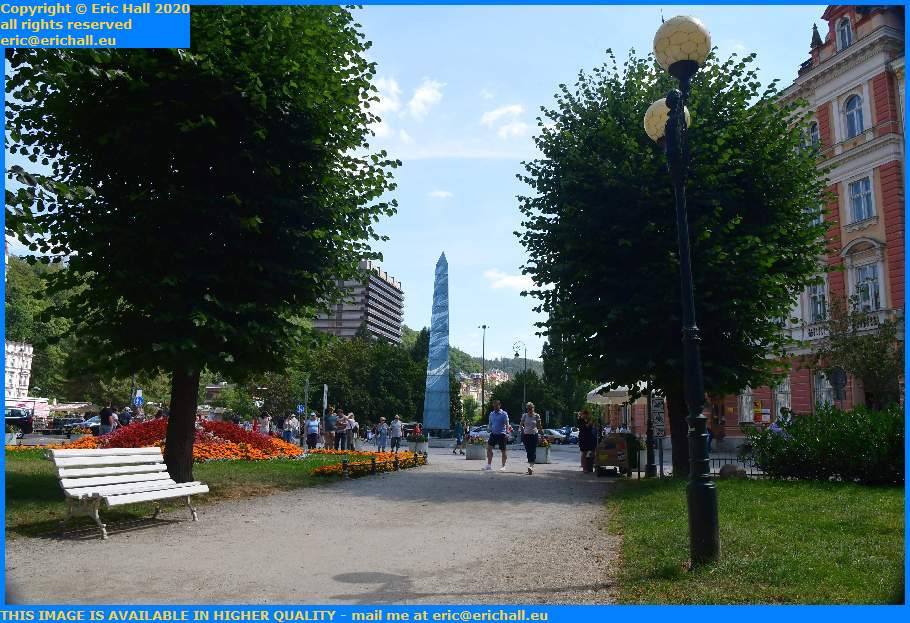 Just to my right in the previous photo is the obelisk that you can see in this photo, the Samec Kubicek Obelisk.
Just to my right in the previous photo is the obelisk that you can see in this photo, the Samec Kubicek Obelisk.
It’s a symbolic feature, so we are told, and it’s supposed to represent the boundary between “the peaceful spa area and the excited rhythm of the business zone”.
And if you think that this is pretentions prose, then how about “The pregnant stern silhouette of the obelisk was permeated and visually softened by the bluish light energy from the translucent glass fields with sandblasted drawing and the rounded lines of water splashes”? I don’t want anyone ever criticising any pretentious prose that I might have written when they have this kind of prose to contend with.
The obelisk is situated in the middle of a fountain, a fountain that I didn’t think was all that impressive.
 Through the shopping area I went, and came out the other side into the Varsavska where there was a street market stall selling fruit.
Through the shopping area I went, and came out the other side into the Varsavska where there was a street market stall selling fruit.
The fruit looked quite delicious and I was tempted, until I saw the swarms of wasps around them. I didn’t want the wasps transferring their attention to me and so I declined the opportunity.
It was interesting to see the “Slovensko” on the edge of the awning over the fruit. That of course is “Slovakia” in the Czech and Slovak language.
The big building behind it with the nice cupola is the former Municipal Market Building. In a sign of the time these days, it’s a supermarket and pharmacy.
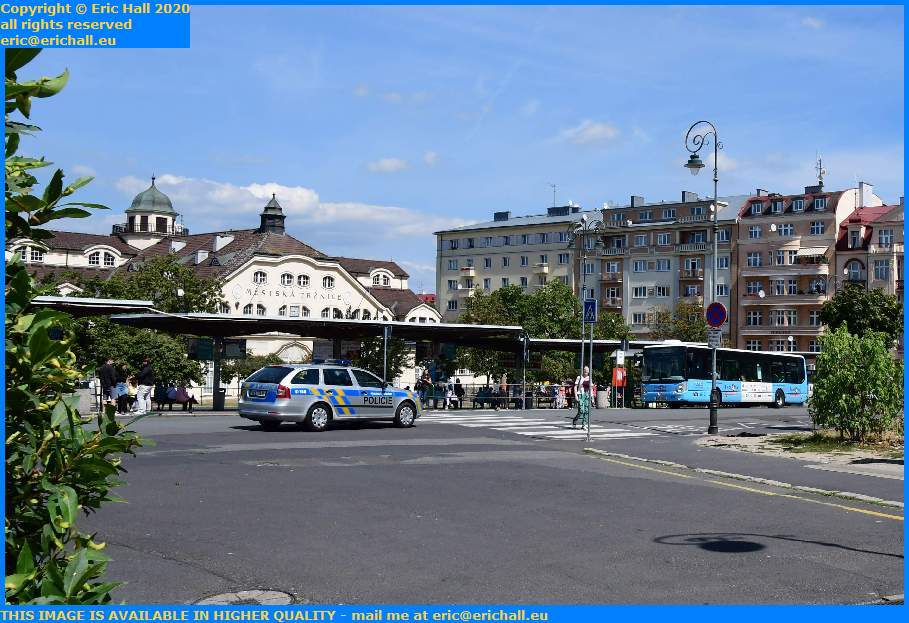 In front of the Municipal Market Building is the local bus station.
In front of the Municipal Market Building is the local bus station.
The bus service around the town was something that impressed me considerably. There were quite a few stands at the bus station with a regular stream of vehicles, and also a large crowd of passengers waiting to board them. It seems that public transport is quite a big thing around here.
It seemed to be quite a friendly town for pedestrians. Plenty of streets are closed to motor traffic as we have already seen. I headed off up one of them back towards the quieter part of the town where all of the tourists hang out.
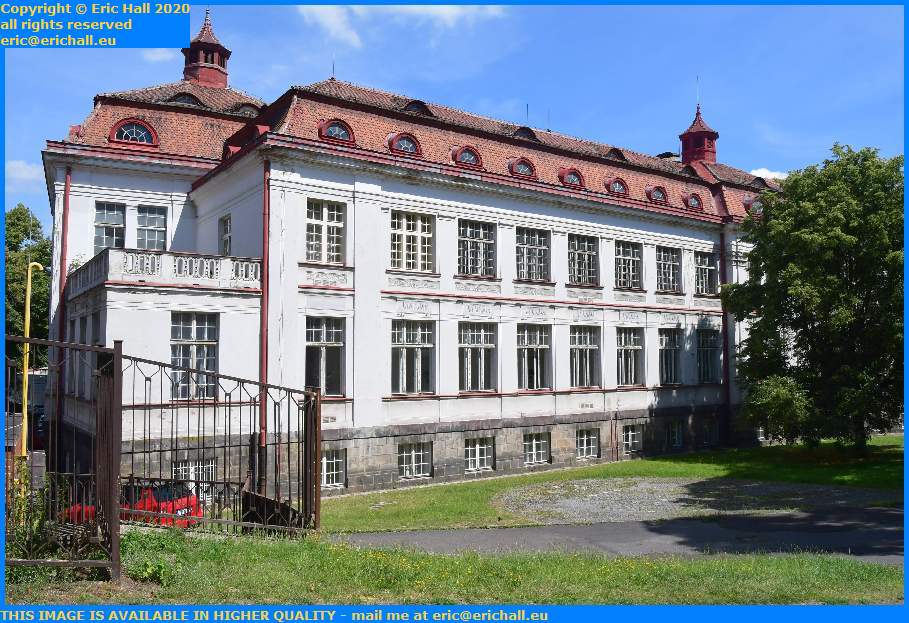 On the way back from the commercial end of town I passed by this rather gorgeous but very shabby building.
On the way back from the commercial end of town I passed by this rather gorgeous but very shabby building.
It’s actually a building called the Alžbetiny Lázne, otherwise known as the Elizabeth Spa. And just in case you are wondering who the Elizabeth might be, she was the Empress Elizabeth, more widely known by her nickname “Sissi”.
Born of the Wittelsbach family in Bavaria where we were the other day, she married the Emperor Franz Joseph, seven years her superior, when she was just 16 and was immediately thrown into the limelight to which she was totally unaccustomed. she struggled against her mother in law in an attempt to influence her husband but was particularly unsuccessful.
In the end she fell victim to the Anarchy movement, being assassinated by an Italian anarchist in 1898.
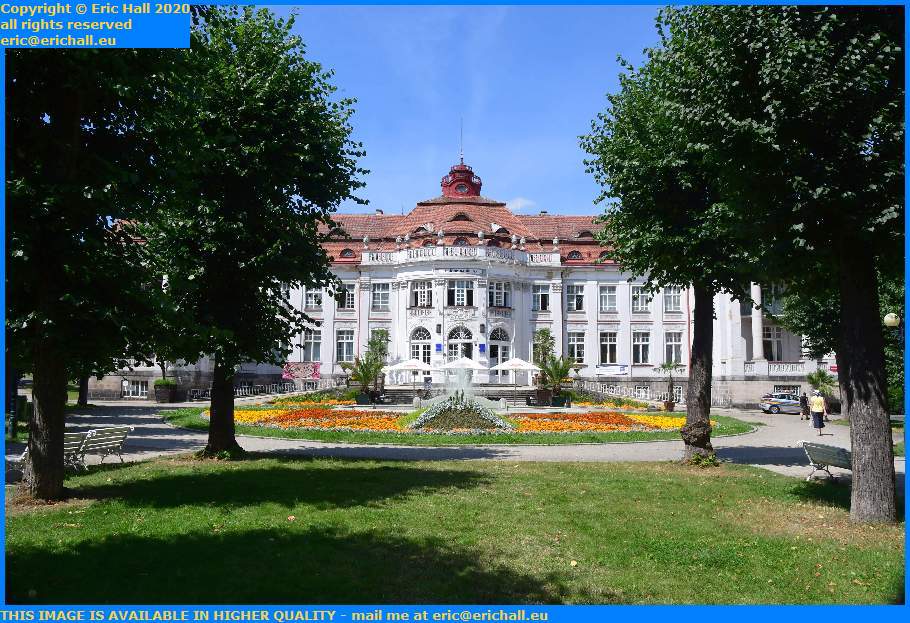 The building and its Spa were designed in the pseudo-baroque style by the Municipal Architect Franz Drobny. It was built between 1905 and 1906 and formally opened on 18th June 1906.
The building and its Spa were designed in the pseudo-baroque style by the Municipal Architect Franz Drobny. It was built between 1905 and 1906 and formally opened on 18th June 1906.
After the creation of Czechoslovakia, the Spa was renamed as the much more banal “Spa Five”. It was renovated between 1969 and 1973 and again about 20 years ago. While the interior might be the State of the Art, I wish that they had spent some time on the outside because it’s not as good-looking close to as it does from a distance.
In front of it is a fountain featuring the statue of a nude girl, designed in 1963 by Bretislav Benda.
There’s also a very smart little park in front of the building that you might have seen earlier in the photo of the pyramid thing. It’s called the Smetana Park, named after the Bohemian composer Bedrich Smetana.
Having brought a book and a bottle of water with me, I sat down and rested for an hour or so. I can’t say that I didn’t need it.
Now that I was rested, I went off and found something to eat for lunch. There was an Italian guy selling pasta and pizza from a stall and we ended up having quite a little chat in Italian. And then I headed off in the general direction of home, on the other side of the river to which I came.
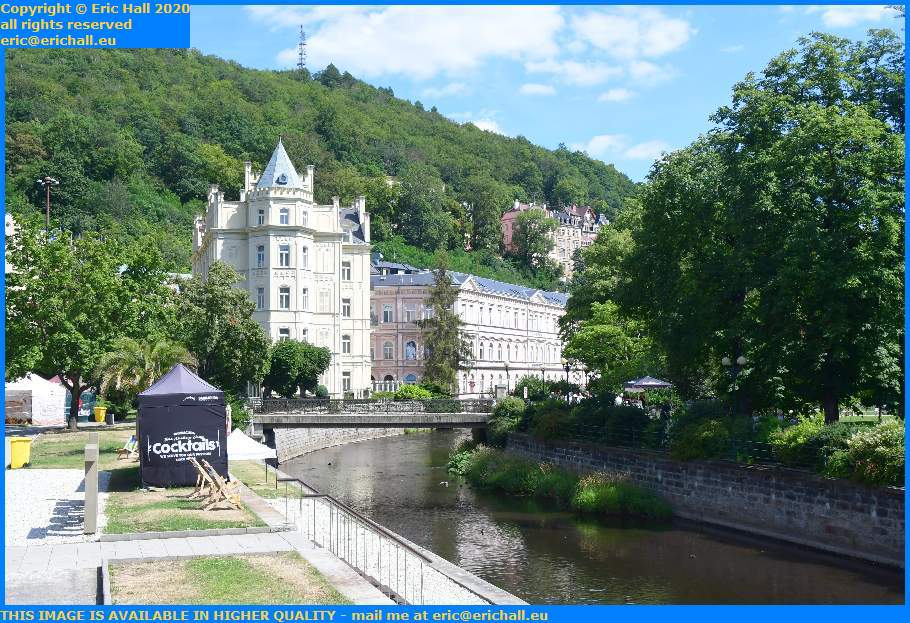 This buiding over there in the Ivana Petrovice Pavlova is the Hotel Pavlov.
This buiding over there in the Ivana Petrovice Pavlova is the Hotel Pavlov.
What’s exciting about this building as far as I am concerned is its shape. And when you look at it and compare it to the famous “flat iron” on the corner of Broadway and Fifth Avenue in New York, it just goes to show what you can do with a little imagination, something of which is desperately lacking in almost every single piece of architecture in the USA.
The building behind it to the right in the photograph is interesting too. It was probably an old hotel or something similar at one time but now it’s a kind of shopping centre now with quite a few little boutiques in there. I went in there for a good look around but there was nothing in there that was of any interest to me.
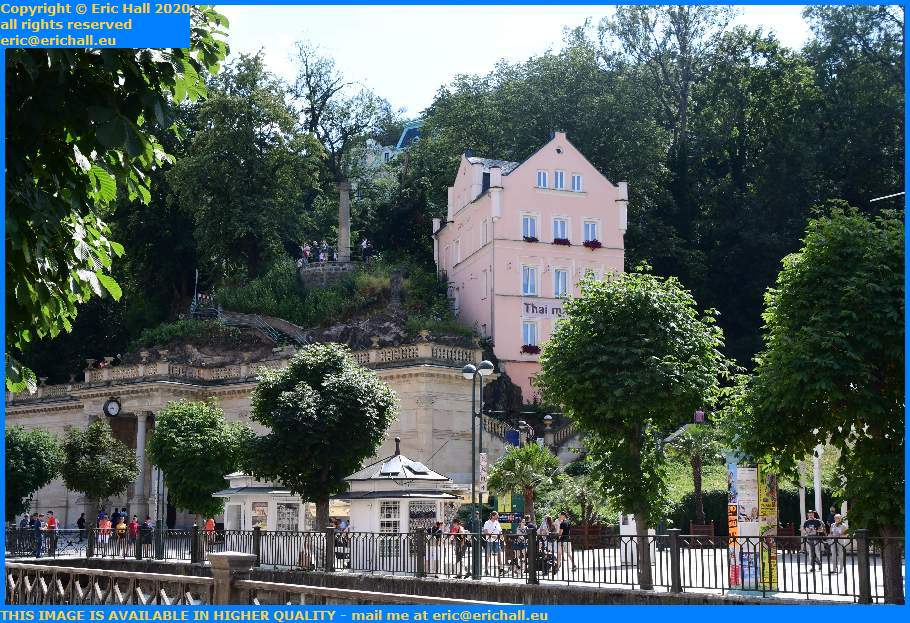 Coming out of the little shopping centre I had a look across the river to see what I could see.
Coming out of the little shopping centre I had a look across the river to see what I could see.
Over there is some kind of obelisk over there reached by several flights of stairs. Where it’s situated is called the Vyhlídka nad Mlýnskou Kolonádou which, crudely translated by Yours Truly, means “The Viewpoint Above The Mill Colonnade”. I’ve no idea if the colonnade has any significance because I didn’t go up to look.
The building to the right is the Tawan Nikolina, the Villa Nikolina. That’s now a Thai spa and massage centre and right now I could do with paying it a little visit myself after all of my exertions just now.
By now it was time for me to make a start on my walk back home so I began to retrace my steps back to my hotel.
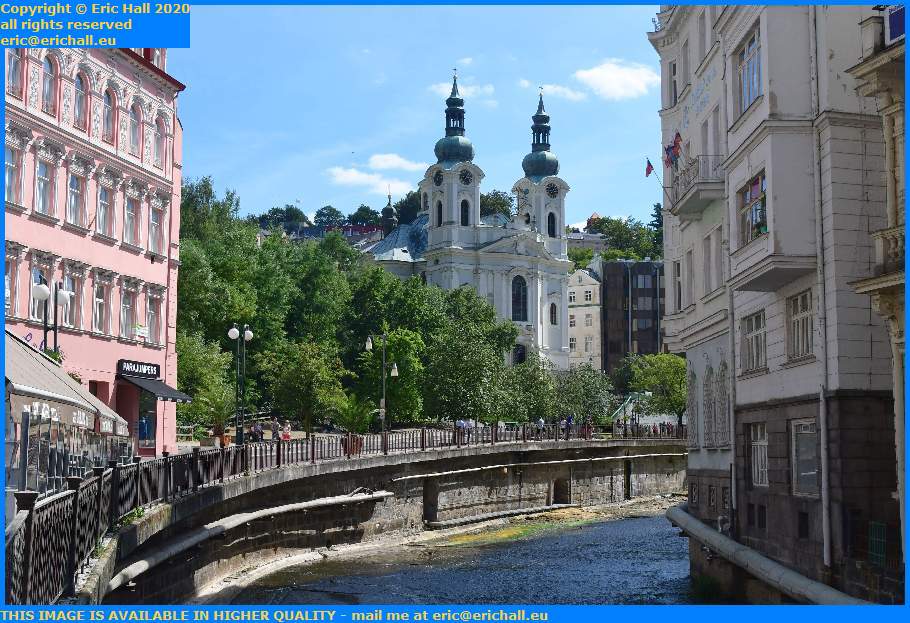 This is the Church of St Mary Magdalene that I missed on my way into town.
This is the Church of St Mary Magdalene that I missed on my way into town.
Designed by the Bohemian architect Kilián Ignác Dientzenhofer, it was built in the High Baroque style between 1733 and 1736 to replace a previous church that dated back to the 14th Century but which was in poor condition following a couple of fires.
It’s actually built on top of the crypt of the previous church and you can go down there to have a look at the remains of several people who were interred there during the life of the previous church. Unfortunately it was closed when I went there so I missed out on that and also in seeing the magnificent altar.
Incidentally, in 2010 the church was added to the list of National Historical Monuments.
 After the Church of St Mary Magdalene I found myself back at the Vrídlo – pramen c1, otherwise known as “Hot Spring Number One”.
After the Church of St Mary Magdalene I found myself back at the Vrídlo – pramen c1, otherwise known as “Hot Spring Number One”.
Because of the pressure of the water in this spring and the amount of carbon dioxide in it, the jet can in some circumstances reach up to 12 metres in height and a temperature of 73°C. Whenever it reaches those extremes, you won’t find all these people loitering around in the vicinity.
On the hill in the background up on the hill is the Diana Observation Tower. That’s probably the place where the view of the town and the surrounding area is the most interesting. It’s been a favourite place with walkers.
They built a funicular lift up to the top of the hill in 1909 and in 1912, to accommodate the increase in visitors, local architect Anton Breinl designed the tower that is now up there. That was opened to the public on 27th May 1914, just in time for the conflict that folllowed.
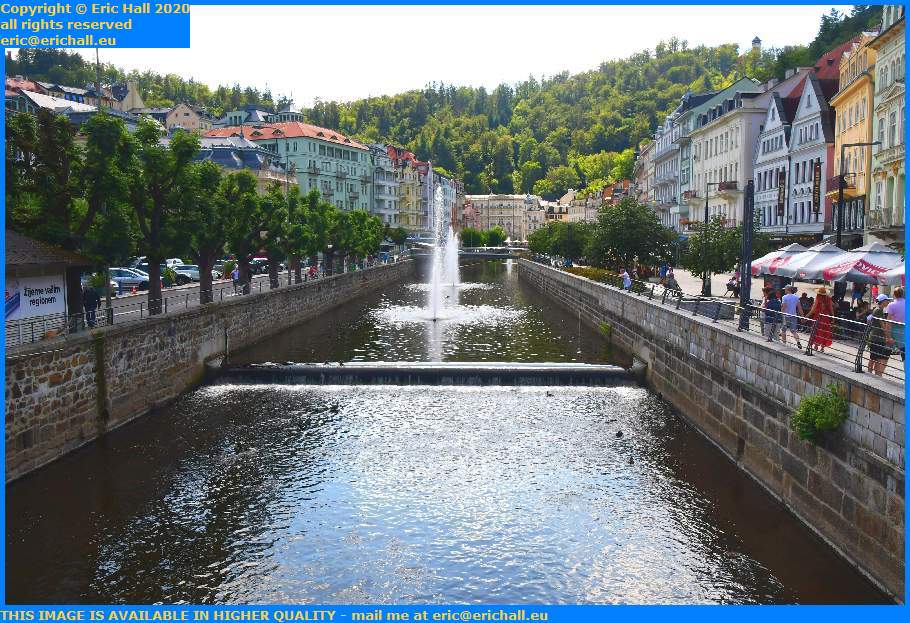 A few steps further on I can stand on a bridge overlooking the river and admire the fountains that I saw on the way in.
A few steps further on I can stand on a bridge overlooking the river and admire the fountains that I saw on the way in.
And the esplanade there on the right alongside the river is all terraced out with seats and tables from the cafés in the immediate vicinity. It’s an ideal place to relax even if the shade is rather limited – or, at least it would have been until I saw the prices that they were charging for a coffee. I only wanted a drink – I didn’t want to buy the table and chair.
Instead, I strode off on my way down the street looking for something at a more democratic price. The spring water was out of the question of course. It’s much too warm in this kind of weather, but I was confident that I would find something as I travelled along on my way back to my hotel.
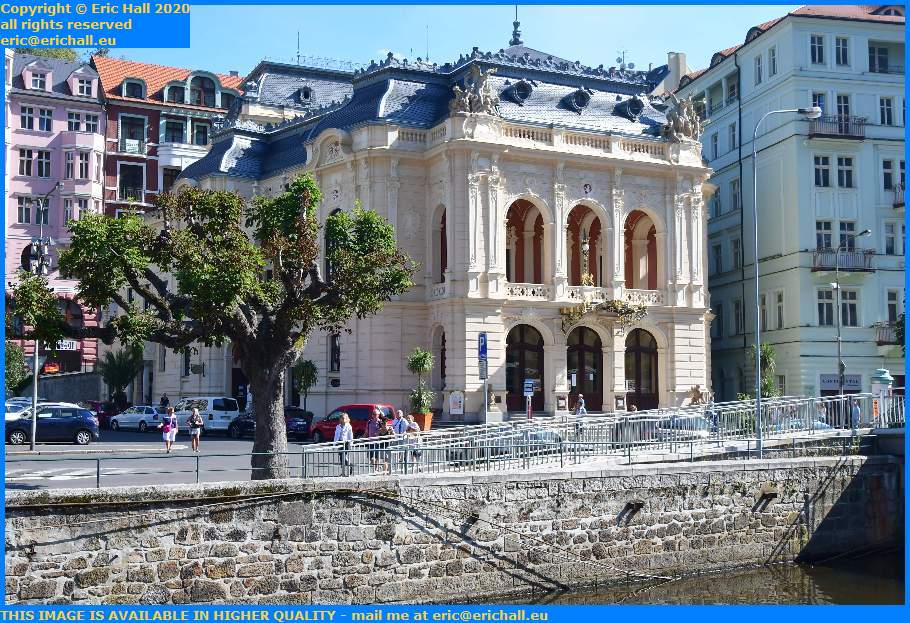 One of the most exciting buildings in Karmlovy Vary is the City Theatre.
One of the most exciting buildings in Karmlovy Vary is the City Theatre.
This was designed by the architechts Fellner and Helmer who designed several other buildings in the town, including the Market Colonnade and the Blanenský Pavilion, of which the Park Colonnade is all that remains. Building began in 1884 and it opened in 15th May 1886 with a performance of “The Marriage of Figaro”.
And that reminds me of the story of the time that someone asled me if I knew about “The Marriage of Figaro” and “Madame Butterfly”. I replied that I didn’t even know that they were engaged.
The interior is just as magnificent as the exterior, with chandeliers, paintings and sculptures designed by a whole host of local painters and sculptors and that’s another building that I would have loved to have visited had it been open to the public at the time when I went past.
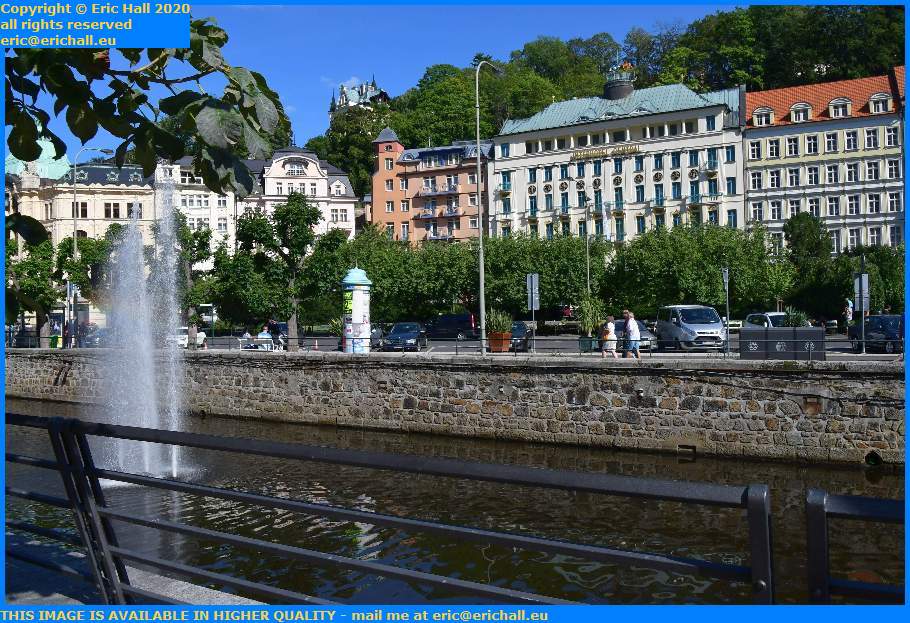 Across the river from where I’m walking on my way home is the Interhotel Central, very proud of its “hundred-year history”, something that features prominently in everything that you ever read about the place, although they never seem to go into any details about it.
Across the river from where I’m walking on my way home is the Interhotel Central, very proud of its “hundred-year history”, something that features prominently in everything that you ever read about the place, although they never seem to go into any details about it.
It’s actually a sanatorium and deals with gastric diseases, and is also a rehabilitiation centre for post-cancer issues. I made a note of the latter for my own purposes, as well as a note of the former if my cooking doesn’t improve.
And I wish that I’d found out more about the building that we can see in the rear to the left in the Lubusina. That’s probably one of the most exciting and interesting buildings that I’ve seen in the town and I could quite happily settle down in a place like that.
As I wandered along the side of the River Tepla on my way back, I came across an Ice-cream stall selling vegan ice cream. In the heat, and having been defied in my attempts to buy a coffee, I stopped and bought one of the aforementioned and took myself off to a quiet place in the shade to eat it.
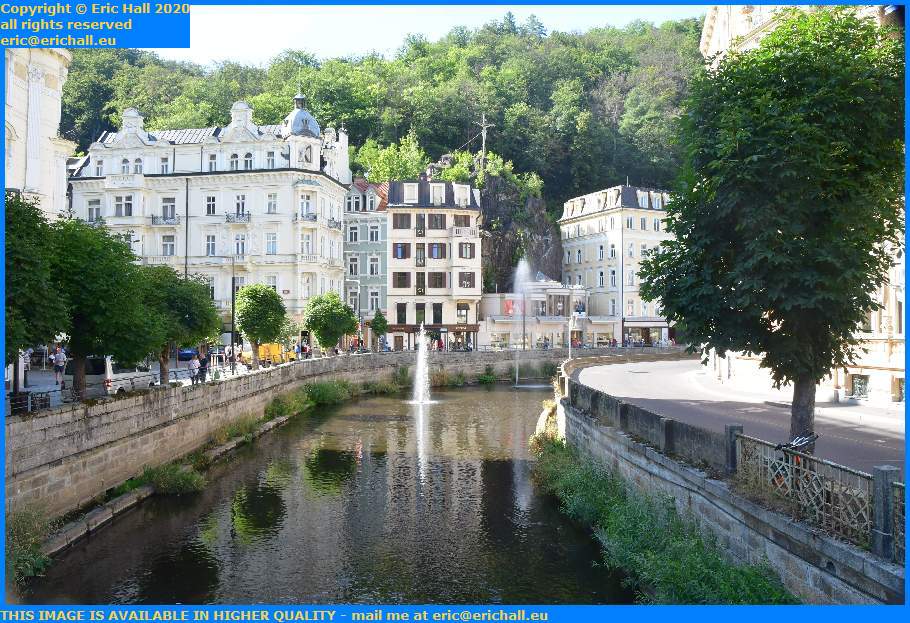 So while I sit here and eat it, I can reflect on my visit to Karlovy Vary before I leave the town.
So while I sit here and eat it, I can reflect on my visit to Karlovy Vary before I leave the town.
It’s a beautiful town. Some of it is very much decayed but other parts are well maintained and there is quite a bit of renovation. Plenty of new build too, but unfortunately it doesn’t blend in with the late 19th Century splendour.
And splendour there is a-plenty. It looks really nice today – a fine example of a Bohemian city – but imagine what it must have looked like at the height of its fame in 1913 before World War I destroyed the Austro-Hungarian Empire and we had all of the Sudeten nonsense. It must have been magnificent.
Back home was uphill of course and that wasn’t as easy as going down to town. However using the old British Army marching order of 50 minutes march with 10 minutes rest for every hour I made it back home safe enough.
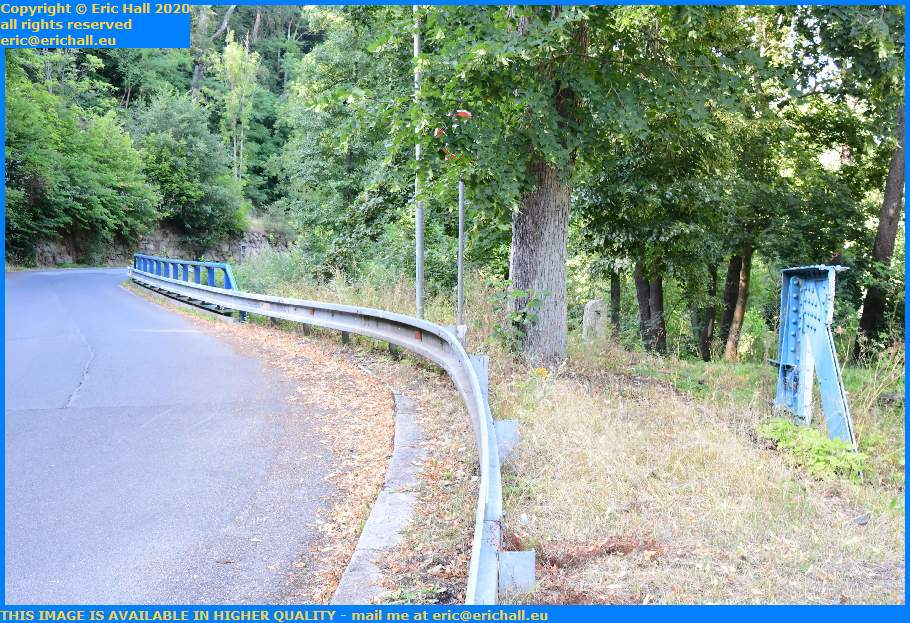 Not before I’d had a good look at this though – something that caught my eye on my way back to my hotel.
Not before I’d had a good look at this though – something that caught my eye on my way back to my hotel.
The bridge over the River Tepla here is a reasonably new one but on the right here are some vestiges of a previous construction that might possibly have been of z girder bridge that might have been previously on the site.
It’s interesting, if not amusing, to think about the bridge that might previously have been here and to wonder about its fate. Was it blown up by the Czechs in 1938 during the German invasion? Or was it blown up by the Germans as they retreated north-westwards from the invading Americans?
Or was it simply dismantled when the new bridge was built here? Or is it nothing to do with the bridge at all?
Finally back in my hotel room I crashed out for a while . And waking up, I set tea on route while I had a good shower, shave and clothes wash. And I needed it all too.
Even though it’s early, I’m now off to bed. It’s been a long, tiring day and I’m going to be doing the same tomorrow too. It’s been years since I’ve being this way and I intend to make the most of it.